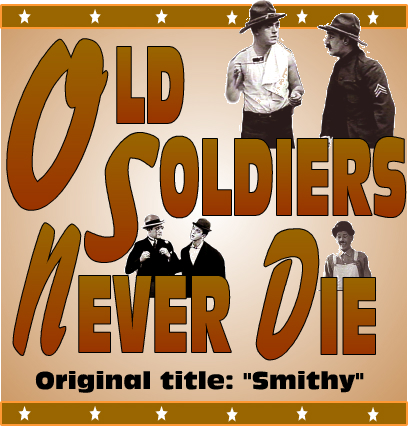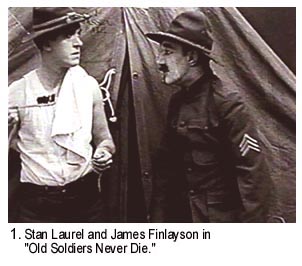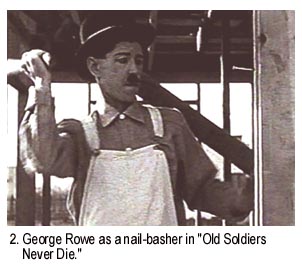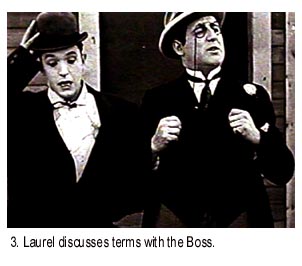

Stan Laurel went over to America with Fred Karno's Company
(along with Chaplin) and started in films in 1917. "Old Soldiers
Never Die" (1924), typical of his early films, was directed
by George Jeske and closely supervised by Hal Roach, and marks
another stage in the story of this famous Comedy Factory.
Snub Pollard and Our Gang occupied the rest of Roach's attention
at the time. James Finlayson was also a newcomer. After stage
experience in England and America, he worked for several film
companies before joining Mack Sennett Comedies. At this period,
Oliver Hardy was making comedies with other companies (e.g., for
Vitagraph, supporting Larry Semon), and he and Laurel first teamed
in 1926 in Hal Roach  comedies
distributed through Pathé (although
they had appeared together in 1921 in "The Lucky Dog,"
although not as a "team"). Their recent pictures,
e.g., "The Big Noise" (1944 by Malcolm St. Clair), therefore
mark a good long run in the comedy headlines. Moreover, James
Finlayson and George Rowe continued to appear for a long time
as their supports.
comedies
distributed through Pathé (although
they had appeared together in 1921 in "The Lucky Dog,"
although not as a "team"). Their recent pictures,
e.g., "The Big Noise" (1944 by Malcolm St. Clair), therefore
mark a good long run in the comedy headlines. Moreover, James
Finlayson and George Rowe continued to appear for a long time
as their supports.
"Old Soldiers Never Die" is an Army-cum-Building
comedy with a vicious circle story . . .
1. Private Stanley crosses swords with Sergeant Bing.
2. Stanley is demobbed and gets job in Builder's yard
3. Bing ditto, ditto, so sword-crossing continues
4. Accidentally, Stanley gets put in charge; the house they build
collapses
5. They re-join the Army and continue as (1) above
The film opens with an iris-in long-shot looking down the lines, the iris being delayed as a bugler sounds a call. Then soldiers rush from the tents and fall in under Sergeant Bing. The C.O. suggests that someone is missing. The title "Stanley again, Sir" affords the necessary indirect introduction to Laurel, providing the pleasurable anticipation of finding the comedian in some sort of absent-minded predicament. Bing looks into tent after tent. Then in mid-shot, Stanley saunters out of his tent, weighs up the weather, and prepares to wash his teeth with an enormous toothbrush. The rambling title is probably an addition in the abbreviated version. In CM.S., toothbrush poised, he pauses as the Sergeant dashes up (Still No. 1), squeezes out the toothpaste in his agitation, and is chased on parade with loose jacket and one puttee still to be put on (which he tries to do whilst marching up and down) - all the while receiving kicks from the Sergeant and bumps from the rest of the section, causing comic, if familiar, difficulties.
Settled in place at last, Stan is informed of his demobilization, so he salutes and hurries off, blowing kisses to all. A cut-in C.S. of the C.O. shows him piqued, but not astonished.
Withdrawing his civvy clothes, Stan contrives accidentally to take a colleague's bundle, which he has decided are of superior quality. So we expect, and are gratified to see, that he emerges in clothes far too big. In the meantime the whole section has been demobbed except Bing, who is thus infuriated at Stan's jeers. With difficulty, due to over-long sleeves, Stan shakes hands with the C.O. who adds that Bing will be free the next day.
 Stan, after a job, walks into
a L.S. of a builder's yard in which a queue of applicants fills
the space between two windows - each of which bears a hand pointing
to the other with the note "Apply next window." He goes
to one end but is slung to the other with a rolling effect, being
spun down the queue. He lights a cigarette, and, in a moment,
his packet is going down the line - the last man discarding it,
empty. Similarly, he passes down the line giving lights from his
cigarette and so is back at the first window.
Stan, after a job, walks into
a L.S. of a builder's yard in which a queue of applicants fills
the space between two windows - each of which bears a hand pointing
to the other with the note "Apply next window." He goes
to one end but is slung to the other with a rolling effect, being
spun down the queue. He lights a cigarette, and, in a moment,
his packet is going down the line - the last man discarding it,
empty. Similarly, he passes down the line giving lights from his
cigarette and so is back at the first window.
This action is very well covered in CM.S., M.S. (pan) and establishing L.S., with sparkling quality in brilliant sunlight. Then Stan laughs right at the camera at his good luck - and raps on the window. He looks away and raps again, but now there is a bloke's head there, and he is none too pleased and points saying, "Apply next door, please." So poor Stan is dispirited (the situation is a forerunner of the later crying scenes, now famous), and walks away. But just then the Boss drives up and takes him in.
This player - William Gillespie - is a familiar figure in Hal Roach comedies. He is often to be seen with Snub Pollard or Will Rogers in the many comedies available on 9.5mm and 16mm, and he appeared in Harold Lloyd's "Safety Last" (1923) as the publicity manager. Here he instructs the typist to give Stan a starting note. He paternally pats his new messenger boy. Stan leans on the typist's desk which closes, concealing the typewriter. He looks for it in bewilderment. The girl laughs and hands over the starting note. He reaches for it, but his over-sized sleeve conceals his hand. So he pulls the hand out with the other hand - a good gag, well put over. Fade out.
The Foreman is sawing a plank as Stan walks up, directed by George Rowe in the background. Naturally Stan puts a foot on the plank and upsets everything, particularly the Foreman. But the latter soon calms down and instructs him to get on with the roofing. The set is a skeleton house, in construction, on the Hal Roach lot which will also be familiar to many as the scene of various affairs of Lloyd, Pollard, Bebe Daniels, and Our Gang. One sublime L.S. shows Stan setting off up the ladder with a roll of roofing felt. His bowler falls off so he descends for it. But he starts back without the felt, re-descends and finally up again, complete. Then a C.S. of the Foreman exhorting him to quit stallin' an' get cracking.
A title redundantly explains that Bing is demobbed and gets
a job at the same yard. Then crisply . . .
a. L.S. Bing walks along by house carrying two buckets
b. L.S. Stan puts down roll of felt on roof; it rolls over the
edge and . . .
c. L.S. (as a) coshes Bing good and proper
Bing is indignant and sets out to administer justice, but
neatly, Stan descends one ladder just as he climbs up to the roof.
After a fruitless search of the roof, Bing descends just as Stan
re-ascends. This is  all
covered in L.S., but the angles are shrewdly chosen. The gag is
repeated as Stan goes down again. But this time, Bing stays on
the roof only to be bowled over the edge as San carelessly pushes
the roll over the apex, and it trips him up. Meanwhile, in a CM.S.
all to himself, George Rowe completely fails to drive in a nail
till he covers his eyes and takes a successful shot in the dark
(Still No. 2).
all
covered in L.S., but the angles are shrewdly chosen. The gag is
repeated as Stan goes down again. But this time, Bing stays on
the roof only to be bowled over the edge as San carelessly pushes
the roll over the apex, and it trips him up. Meanwhile, in a CM.S.
all to himself, George Rowe completely fails to drive in a nail
till he covers his eyes and takes a successful shot in the dark
(Still No. 2).
Stan next proceeds with tarring the roof, ending in the usual chaos and mess. Walking away, his foot goes through the roof, and he saws a plank to make this good. But, of course, Bing was standing on the other end of this plank, so another crash results, followed by another fight, duly interrupted by the Foreman. This is a good sequence, straightforwardly presented. Stan is forcibly stopped by the messenger boy and handed a letter. This (printed, not typed, a queer error) puts him in charge, so he bosses the Foreman, and Bing is chucked out.
Then the Boss returns, discovers Stan was given a letter
addressed to his assistant Mr. Standley by the new messenger boy,
and hastens to the scene to find the house just finished. So Stan
keeps his new job. (The coincidence, improbabilities, and illogic
are here quite frightening, which is unsatisfactory as the film
never quite decides whether it is burlesque or realistic comedy,
i.e., of the "Dynamite" [see Chapter 21] or "Doing-Doing-Done"
[see Chapter 7] types, respectively). In CM.S., he takes the Boss
aside to discuss terms, and in full L.S., the house collapses.
All rush forward except Stan, who walks up rather meditatively.
Then, very nicely . . .
a. CM.S. Boss raises his hands to Heaven; Stan turns and says.
. .
b. TITLE "Excuse me. I have an appointment."
c. CM.S. (as a) he says, and walks away. Boss hurls his hat to
the ground . . . Fade out.
d. L.S. Fade in. Stan walks down the lines (same angle as first
shot in the film) . . . and meets the C.O. again, and then meets
Bing again. Chase. The End
A brief summary comparing this film with "Dynamite"
will be of interest . . .
SCENARIO: "Dynamite" scores in this phase, the construction
being notably superior. "Old Soldiers" is rambling,
its epilogue is so obvious as to be an anti-climax, and it works
in music hall turns that give it an episodic air. The improbabilities,
which suit "Dynamite," are another weakness.
DIRECTION: A slick hand guided "Dynamite," and the groupings, timings, and reactions are good enough to repay study by anyone embarking on production of a farce -comedy. On the other hand, the Hal Roach style was deliberately more subdued and held lots of detail. The cigarette gag is typical.
PHOTOGRAPHY, DESIGN, MONTAGE: As straightforward, realistic and slick as possible, all absolutely typical of the school of American Comedy, and admirably efficient.
TITLES: Hal Roach comedies never reached notable heights in witty subtitles, and though Stan's mild "Excuse me, I have an appointment" is sublime, Dynamite has some really classic specimens, as quoted. (Ed. note: Since intertitles [i.e., "subtitles"] were often changed for overseas distribution, Mr. Bulleid's opinion regarding Hal Roach "subtitles" must be regarded with that fact in mind. Most historians consider the intertitles found in Hal Roach comedies to be very witty and clever, as evidenced by the work of such talented title writers as H.M. Walker.)
ACTING: Hamilton walks through a succession of gags with a pleasantly and constantly astonished demeanor, whereas Laurel puts in more personal touches such as finding his hand halfway down his sleeve - but the former is undoubtedly the more successful performance, because Laurel still carried traces of stage acting, and his laughter and gesticulations are at times irritating. Note from his present-day performances how completely he has corrected these faults. - whereas he maintains some of the gags typical to his style, e.g., the stupid placing of two ridiculous bits of wood to block a large hole he has made in the roof. Both the stars receive about equal support, though a special mention must be made of the Walking Delegate played by Lawrence A. Bowes. This is a really delightful performance of top-hatted villainy and makes one regret that the trade seems so frightened of making burlesques.
GENERAL: The general audience reaction to these old comedies is "Why are they never made now?" Of the 56 short films issued from Feb 21 to March 20 this year, only six are comedies, of which one is a reissue; (There are also six cartoons). That is, five are new ones in four weeks, whereas in 1917-19, Harold Lloyd alone was making one a week! Perhaps after the war, the pendulum will swing back ....
Grateful thanks to David Wyatt for his invaluable help with this article.
Also, thanks to Brent Walker for identifying the "Walking Delegate" in "Dynamite" as Lawrence A. Bowes.